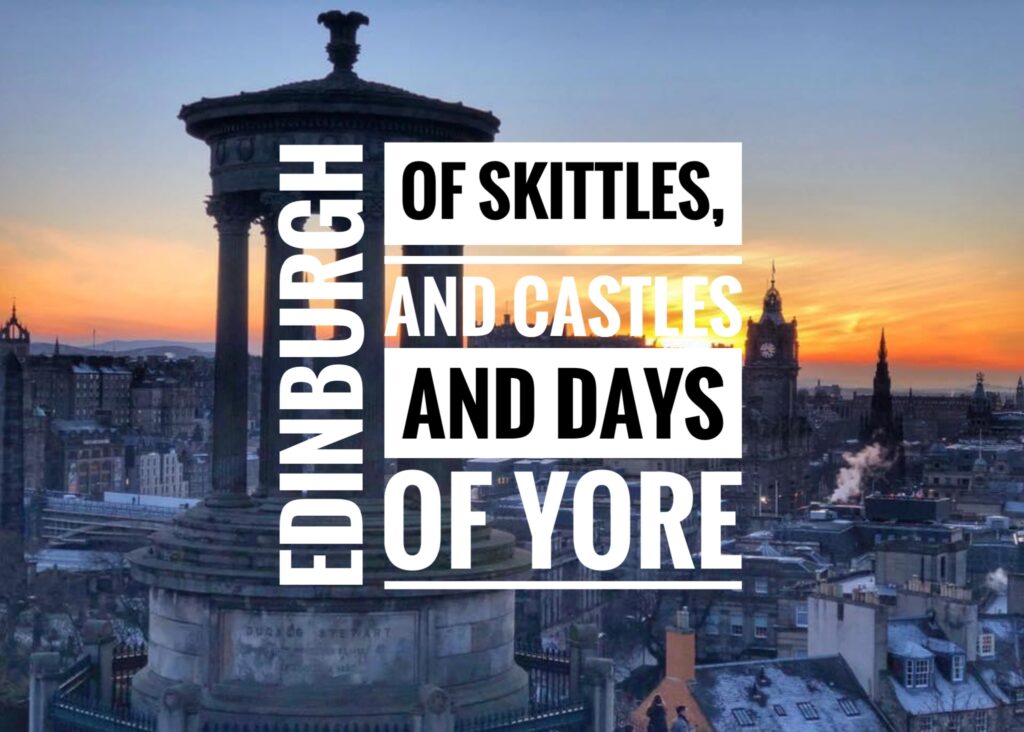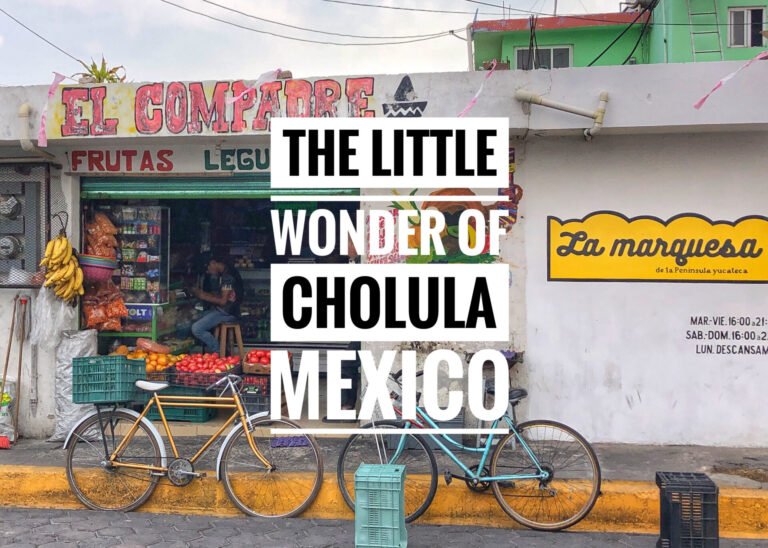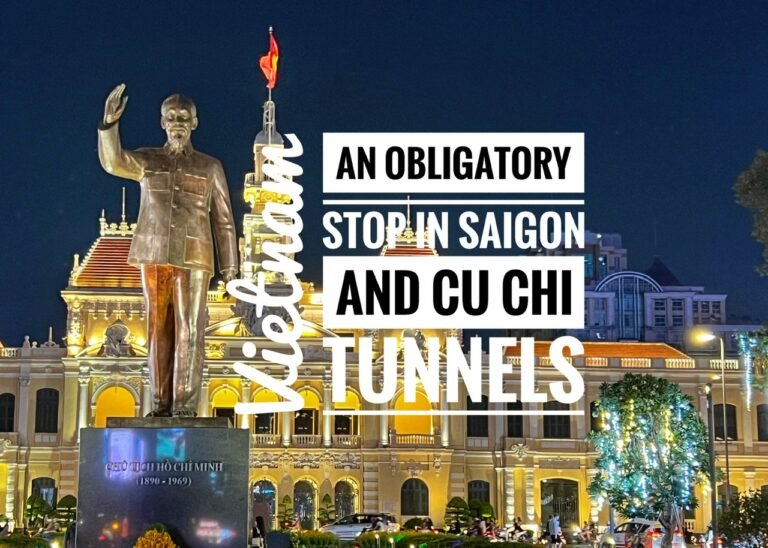
From medieval masterpieces to royal remnants to lush landscapes, this UNESCO treasure founded prior to 7th Century AD, Edinburgh is unlike any city we’ve seen. After wrapping up our Knaresborough housesit, it seemed only appropriate to meander north for a gorgeous glimpse, and a flight deal ($36/ticket…yes, cheaper than a bus) on our journey back to the south of England.

As we often do, we kicked off our time in this city with a free walking tour. What’s the difference between a church and a cathedral? A cathedral is generally bigger and is also the seat of a bishop. Therefore you typically only see one cathedral per denomination in a city. St Giles Cathedral has been a religious focal point in Edinburgh for 900 years and is certainly a showpiece with its a one of a kind crown steeple.

This medieval building has been uncovered so you can see the outline of the stairs. Notice anything about them? Yes, one of them is bigger than the others so a thief would naturally trip on it in the middle of the night. Many medieval buildings had these, and is where the phrase “trip alarm” came from.

One of the many historic pubs in the city. Deacon Brodie is one of the inspirations behind Robert Louis Stevenson’s Jekyll and Hyde.

Speaking of Stevenson, we got to take a look at his life at the Writers Museum (free) housed in the 1622 Lady Stairs’ House. In addition to “Dr Jekyll and Mr Hyde,” Stevenson is also known for “Treasure Island.” The museum also honors Walter Scott and Robert Burns.

Edinburgh Castle is the dominating character of the city skyline. There has been a royal castle on the rock since at least the reign of David I in the 12th century, and the site continued to be a royal residence until 1633. According to ancestry.com, Mandy is a direct descendant of Dave’s so this is pretty much like visiting gramps’ house. Unfortunately he was nowhere around to cheapen the entrance fee, so we opted to admire it from the outside.

Another view of the castle.

A view of the city from Greyfriars Kirkyard.

The final resting spot of William McGonagell. For Harry Potter fans this may have meaning….Speaking of, those fans need to get to Edinburgh immediately. This city is chock full of Harry Potter inspired institutions, as well as JK Rowling’s home when she was writing the books.

Our walking tour guide gave us loads of good tales of folklore, which Scotland is known for. (And having the unicorn be the National “Animal.”) Mandy gives a pat to Greyfriars Bobby, a Skye Terrier who became famous in 19th-Century Edinburgh for spending 14 years guarding the grave of his owner til he died himself in 1872.

A view down the Royal Mile, which connects Edinburgh’s two iconic markers of royal history-Edinburgh Castle and Holyrood Palace.

Next we opted for a quick climb to a spectacular view of the surrounding lochs and highlands from the top of Arthur’s Seat in Holyrood Park (251 meters). This park was used as a hunting ground for the royals in the 12th Century and is actually one of several ancient volcanoes. Its name most likely came from “archer’s seat” not a royal named Arthur.

The view of Edinburgh from the top of the seat.

Since we skipped Edinburgh castle, we opted to get our castle fix at the nearby, non-tourist trap of Craigmiller Castle for a third of the price ($7.75). This ruined regal gem is best known for its association with Queen Mary of Scots (now playing at a theatre near you!) Following an illness after the birth of her son, the future James IV, Mary arrived at Craigmillar in 1566 to recover.

Royal photo shoot take 1

Take 2

The grand dining hall of the castle. The fireplace was MASSIVE…nearly 8’ across!

One of the castle’s many spiraling staircases.

Mandy practices a regal queen wave.

More views of Craigmillar.

The view of Edinburgh from the top of Craigmiller. You can see Arthur’s Seat on the right, Edinburgh Castle in the middle and the snow-covered highlands beyond. Simply Stunning.

Because we have this absolutely empty double decker bus picture, it seems like a good time to talk about the ridiculousness that is the U.K. transportation system and how challenging it is to figure out as a tourist. (Who, ahem…aren’t exactly amateurs.) You see, in 1980 Margaret Thatcher privatized all public transport in U.K. This might be good for (a couple?) reasons but for us it was incredibly frustrating. It meant that in each town or region there were at least 3-5 bus, tram and train operators and none of them are linked. So you buy a day pass (which is not cheap) and pretty much can’t go where you need to go, or move easily from one form of transport to another. Also, we had constant experiences of extremely early buses, un-user friendly apps, having to use exact fare. Basically, trying to buy passes was like trying to figure out budget airlines baggage policies or learn Ukrainian. Even some of the drivers couldn’t explain it ?. Let’s face it…Some things should be left in the government’s hands and a public service like transport is one of them.

Back in Edinburgh, we explore the alleys of Old Town

And visit the exquisite (tropical) plants in the Royal Botanic Garden’s Glasshouse.

A street scene in Edinburgh new town. “New” means it was built in about the 1750’s.

The silhouette of this city is simply stunning at sunset.

From Calton Hill, the home of Scotland’s government.

The National Monument’s original purpose was to honor fallen Scottish soldiers, and clearly designed after Rome’s Pantheon. Construction was started in 1826 and, due to the lack of funds, was left unfinished in 1829. This circumstance resulted in several nicknames including “Scotland’s Disgrace” and “the Pride and Poverty of Scotland.”

The Holyrod Palace is the official residence of the British monarch in Scotland. Queen Elizabeth comes here for a week each summer to carry out official engagements. It has been in use since the 1600’s.

We were lucky that Sheep Heid Inn was only a 10 minute walk from our Airbnb. This pub has been serving Scottish Ale in this location for more than 600 years!

The pub even featured a historic skittle alley from the late 1800’s. Skittles, we learned, is basically the same as bowling. Not sure if there’s any differences?

An entertaining (and sometimes gag-worthy) dinner menu from 1905.

One of the greatest things about visiting the U.K. on a budget is all the FREE museums! Not only are they all in English, they are jam-packed with wonderful exhibits, comparable to the ones in New York or DC. The National Museum of Scotland was certainly no exception.

Mandy slips into character.

It’s hilarious that a national museum feels the need to point out the fact that the United States is not the center of the western world. ?

The fashion exhibit was fascinating. Clothing from the 1700’s through today.

Most of you might have heard of this famous wooly critter. This is the original Dolly the Sheep, the first mammal to ever be cloned from and adult somatic cell in 1996.

Back exploring Edinburgh, we visit the breathtaking Walter Scot Monument. It is the second biggest memorial to an author in the world. It was finished in 1844.

Dipping our toes in the ocean in January. A nice reminder we’re on an island. It’s about like Oregon, and oh-so-pretty!

Leaving a little piece of our heart behind.

To depart Scotland, our plan was to head out from Edinburgh on a quick $36 easyJet flight to Bristol in the south of England. Unfortunately a snowpocolypse of Portland proportions had hit Bristol. 7 centimeters (less than 3”) had shut down the airport and canceled our flight. ?
Oh, England…. Fortunately EasyJet put us up in a great hotel in the suburbs with perks we don’t usually get like a pool, workout room and buffet. Whoohoo! After a little grumbling, we definitely made the best of it!



